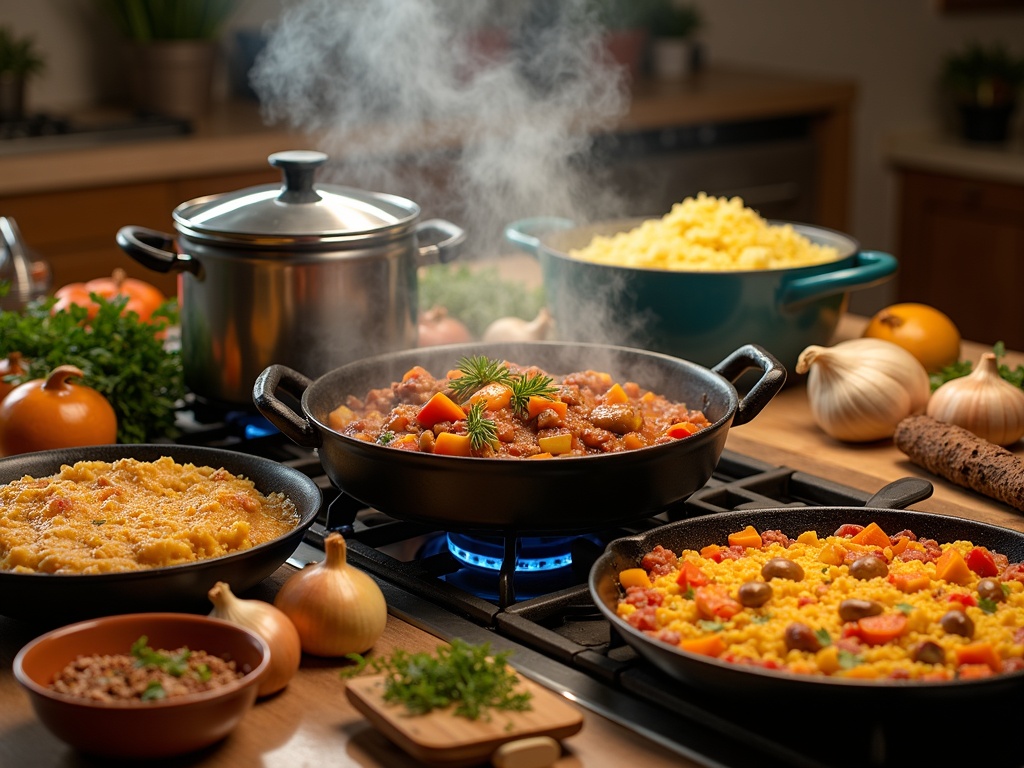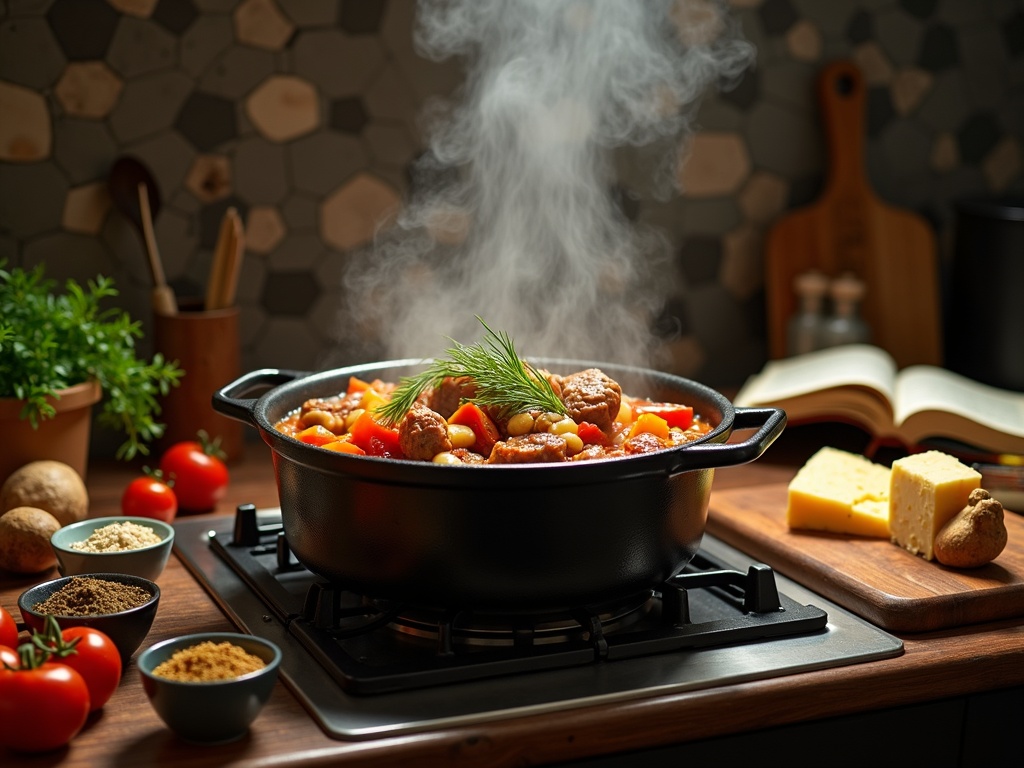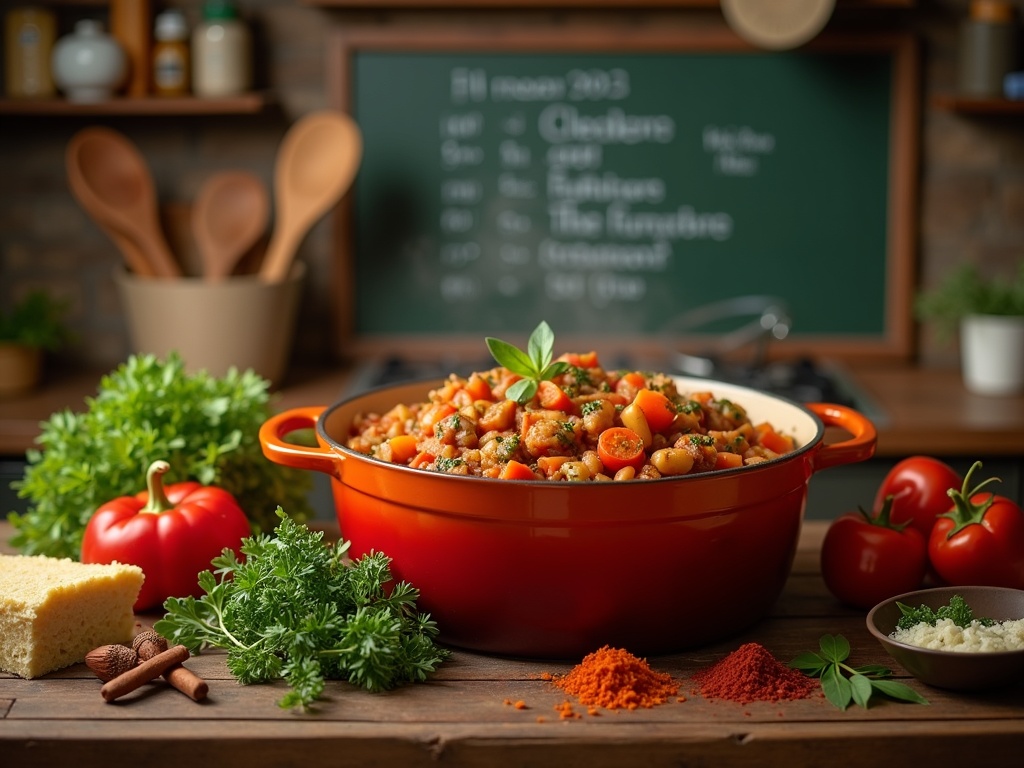One pot cooking has revolutionized meal preparation by reducing cooking time by 30% while delivering incredible flavor through unified cooking methods. This approach streamlines kitchen work by eliminating multiple pans and complex preparation stages and offers significant financial benefits through reduced energy usage and more efficient ingredient utilization.
Find In This Article
Key Takeaways
- One-pot cooking dramatically cuts kitchen workload by allowing simultaneous ingredient preparation and requiring less attention during the cooking process.
- The financial advantages include lower energy and water consumption, reduced food waste, and more economical use of proteins and specialty ingredients.
- This cooking style adapts perfectly to various techniques and equipment, from slow cookers and pressure cookers to Dutch ovens.
- Dishes can be customized to accommodate different dietary requirements without creating separate meals for family members.
- The scientific principles behind one-pot cooking create deeper flavors as ingredients cook together, allowing flavors to meld naturally while simplifying preparation.
Save Time and Money with One-Pot Cooking
I’ve discovered that one-pot cooking is a true game-changer for busy households. Recent data shows a remarkable 30% reduction in overall cooking time compared to traditional methods that use multiple pans and burners. This time-saving approach has become increasingly popular, with 59% of Americans now incorporating meal prep strategies into their weekly routines.
Efficient Meal Preparation
One-pot cooking dramatically cuts down on kitchen work in several ways. First, I’m able to prep ingredients all at once rather than in stages for different components of a meal. Second, the cooking process itself requires less attention – no more juggling multiple pots at different temperatures or cooking times. Third, flavors naturally blend while cooking, eliminating the need for complex sauce-making or separate seasoning steps.
The beauty of one-pot cooking extends to various techniques. Whether I’m using a slow cooker for a hearty homemade chili that simmers while I’m at work, a pressure cooker for quick weeknight meals, or a Dutch oven for a comforting Irish stew recipe on the weekend, the principle remains the same: everything cooks together, creating less work and more flavor.
Many classic comfort foods adapt perfectly to the one-pot approach. A delicious sausage casserole combines protein, vegetables, and starch in a single dish. Similarly, a Spanish paella recipe brings together rice, vegetables, and proteins in one pan, creating a complete meal with minimal fuss.
Financial and Practical Benefits
Beyond the obvious time savings, one-pot cooking offers significant financial advantages:
- Reduced energy usage by heating only one cooking vessel
- Lower water consumption during cleanup
- Less food waste as leftovers are typically more cohesive and easier to repurpose
- Fewer specialty ingredients needed since recipes focus on core components
- More efficient use of protein, which can be stretched further when integrated with other ingredients
The cleanup benefits can’t be overstated. Instead of facing a sink full of pots, pans, and utensils, I only need to wash a single cooking pot plus serving materials. This streamlined approach to cleanup saves not only time but also water and cleaning products.
One-pot cooking also encourages better meal planning. Dishes like cottage pie or chicken lasagna can be prepared in larger batches, providing multiple meals from a single cooking session. This approach is perfect for meal prep enthusiasts who want to minimize kitchen time while maximizing food output.
The versatility of one-pot cooking spans countless cuisines and dietary preferences. I’ve found that this approach works equally well for vegetarian stews, meat-based casseroles, grain bowls, pasta dishes, and even some breakfast options like shakshuka or frittatas.
For beginners looking to save time in the kitchen, one-pot cooking offers an accessible entry point. The simplified process reduces the intimidation factor of complex recipes while still delivering satisfying, nutritious meals. The focus shifts from technical cooking skills to understanding flavor combinations and basic timing – skills that build confidence in the kitchen without requiring culinary school training.
I’ve found that this cooking style not only makes weeknight meals more manageable but also reduces the mental load associated with meal planning and preparation. The simplicity of knowing that dinner requires just one pot, basic ingredients, and minimal attention has transformed my relationship with cooking from a chore to an enjoyable, stress-free experience.
Smart Cooking Techniques That Maximize Flavor
I’ve discovered that mastering one-pot cooking techniques can transform your meals from simple to sensational. The right approach not only saves time but amplifies flavors in ways that multi-dish cooking sometimes misses.
Time-Saving Methods With Maximum Impact
Pressure cookers have revolutionized my kitchen routine, cutting cooking time by an impressive 70%. This efficiency doesn’t sacrifice flavor—it concentrates it. When making a hearty homemade chili, the pressure cooker seals in aromas and forces flavors deeper into the ingredients.
Irish stew where you want to sear meat first, then slow-cook to tenderness.
The beauty of one-pot cooking lies in its varied techniques:
- Steaming preserves nutrients while gently infusing flavors
- Braising breaks down tough cuts into fork-tender bites
- Baking creates golden crusts and caramelized edges
- Simmering allows flavors to meld gradually
Flavor-Building Strategies
Proper layering techniques make the difference between bland and brilliant results. I start with aromatics like onions and garlic as my flavor foundation, then add spices at the right moment to bloom their essential oils.
When creating a rich sausage casserole, I build flavor by searing proteins first, then deglazing with stock to capture those caramelized bits from the bottom of the pot.
Timing also plays a crucial role. I’ve learned to add hardy ingredients like root vegetables early in the cooking process, while reserving delicate herbs until the final minutes to maintain their bright flavors.
For dishes like cottage pie, the layering happens vertically—creating a foundation of seasoned meat, topped with vegetables and finished with a creamy potato layer that browns beautifully.
Temperature control creates magic in one-pot cooking. A slow, gentle simmer allows flavors to develop complexity in stews, while a higher heat delivers the beautiful socarrat (crispy bottom layer) that makes paella so special.
The strategic use of acidity—a splash of vinegar or lemon juice added at the end—brightens flavors and balances rich dishes like chicken lasagna without requiring additional components.

The Health Benefits of Home-Cooked One-Pot Meals
When I cook homemade chili or similar one-pot dishes, I’m not just saving time – I’m making a smart health choice. Research shows people who regularly cook at home have a 25% higher likelihood of meeting their daily fruit and vegetable intake compared to those who frequently eat out.
Nutritional Advantages
One-pot meals make balanced nutrition remarkably simple. By combining protein, vegetables, and whole grains in a single dish like cottage pie, I ensure my meal hits multiple food groups without extra effort. The cooking method also helps preserve nutrients that might be lost when vegetables are prepared separately.
The calorie difference is significant too. A homemade Irish stew typically contains far fewer calories than its restaurant counterpart. This calorie reduction comes without sacrificing flavor or satisfaction – in fact, many people find home-cooked meals more satisfying.
Ingredient Control
The greatest health benefit comes from having complete control over what goes into my pot. When preparing a sausage casserole, I can:
- Choose lean proteins and whole food ingredients
- Reduce sodium by adjusting salt to taste
- Avoid unnecessary additives and preservatives
- Control portion sizes more effectively
- Substitute healthier alternatives for traditional ingredients
This control extends to cooking methods too. Instead of deep-frying or heavy sautéing, one-pot meals often rely on gentler methods like simmering, which requires less added fat.
I’ve found that introducing more vegetables becomes easier with one-pot cooking. Even dishes traditionally light on vegetables, like chicken lasagna, can be transformed into nutrient powerhouses by adding extra greens, mushrooms, or bell peppers.
For families with varied dietary needs, dishes like paella can be customized while still cooking everything together. This approach encourages healthier eating habits without creating extra work or separate meals for different family members.
The simplicity of one-pot cooking also makes healthy eating more sustainable as a lifestyle choice rather than a short-term effort. When nutritious meals become both convenient and delicious, they’re much easier to maintain as part of your regular routine.
Budget-Friendly Meal Solutions
I’ve discovered that one-pot cooking is a game-changer for anyone looking to cut food costs without sacrificing flavor. The numbers speak for themselves – you can expect to slash your food expenses by up to 50% compared to eating at restaurants. This approach to meal preparation combines simplicity with significant savings.
Cost-Effective Cooking Strategies
One-pot dishes excel at transforming affordable ingredients into delicious meals. I’ve found they’re particularly effective at making the most of cheaper meat cuts that typically require longer cooking times. For example, a hearty homemade chili can turn tough, inexpensive beef into tender, flavorful bites through the slow simmering process.
These meals also minimize food waste – something that directly impacts your bottom line. Instead of throwing away leftover vegetables or small portions of meat, I simply incorporate them into my next one-pot creation. That half onion, handful of spinach, or single chicken breast can find new life in a sausage casserole or stew.
The beauty of one-pot cooking lies in its flexibility. I can adjust recipes based on what’s on sale that week or what I already have in my pantry. This adaptability helps me take full advantage of seasonal bargains and store promotions.
Bulk Cooking Benefits
The financial advantages of one-pot cooking extend even further when preparing larger batches. About 70% of families report substantial savings through bulk cooking approaches. I’ve experienced this firsthand by making a large cottage pie that provides multiple meals for significantly less than preparing separate dishes each night.
Bulk cooking saves money in several ways:
- Reduced energy costs by using the stove or oven just once for multiple meals
- Better pricing on ingredients purchased in larger quantities
- Decreased impulse spending on takeout when ready-made meals await in the freezer
- Less food waste as portions can be frozen before they spoil
The initial time investment pays dividends throughout the week. I make a large chicken lasagna on Sunday, then enjoy stress-free meals for days afterward. This approach has transformed my budgeting – both in terms of time and money.
For even greater savings, I’ve learned to plan my one-pot meals around pantry staples and freezer ingredients. An Irish stew can be customized based on whatever root vegetables are most affordable that week, while a paella can showcase seasonal seafood specials.
One-pot cooking also cuts down on equipment needs. I don’t need specialized gadgets or multiple pans to create impressive meals. This minimalist approach means fewer kitchen purchases and less time spent washing dishes – another hidden cost saving.
By embracing one-pot cooking as a core budget strategy, I’ve managed to create delicious, nutritious meals while maintaining tight control over grocery spending. The combination of reduced food waste, smart use of affordable ingredients, and efficient batch cooking has revolutionized my approach to feeding myself and my family.
Meal Planning and Versatility
One pot cooking has completely transformed my approach to meal planning. I’ve found that these simple, efficient recipes serve as the perfect foundation for weekly meal preparation, regardless of dietary preferences or restrictions. By preparing a base dish at the beginning of the week, I can easily modify portions for different family members while maintaining nutritional balance.
Adapting to Everyone’s Needs
The beauty of one pot meals lies in their inherent flexibility. I can customize most recipes to accommodate different dietary requirements without creating separate dishes for each family member:
- Protein swaps: I substitute lamb in my traditional Irish stew with chicken for those watching their red meat intake.
- Grain alternatives: Replacing rice with cauliflower rice in a hearty paella creates a low-carb option.
- Heat variations: Adding spice to individual portions after cooking keeps my homemade chili mild for kids but flavorful for adults.
- Allergy considerations: Making a sausage casserole with gluten-free sausages and thickeners accommodates those with wheat sensitivities.
This adaptability makes family meal planning much more straightforward. I can prepare a single base dish that satisfies everyone’s preferences while ensuring proper dietary intake across the board. This approach has saved me countless hours in the kitchen and significantly reduced mealtime stress.
One pot cooking also excels at efficient food group combination. A typical cottage pie integrates protein (ground beef), vegetables (carrots, peas), and carbohydrates (potato topping) in perfect harmony. This natural balance makes nutritional planning almost automatic.
The convenience extends to leftovers as well. I frequently transform yesterday’s dinner into entirely new meals:
- Last night’s chicken lasagna becomes today’s pasta frittata.
- Leftover stew gets blended into soup or used as pie filling.
- Extra chili converts to taco filling or baked potato topping.
- Unused casserole transforms into hand pies with simple pastry.
This approach reduces food waste while keeping meals interesting throughout the week. I’ve noticed my grocery bills have decreased since adopting this strategy, as I’m purchasing ingredients more thoughtfully and using them completely.
For busy parents, one pot meals offer unparalleled convenience. I can prepare these dishes during weekend downtime, portion them appropriately, and have ready-to-heat options available for hectic weeknights. The reduced cleanup further enhances their practicality for family life.
Seasonal adaptations add another layer of versatility. I adjust the same basic recipes throughout the year—lightening stews with fresh herbs and spring vegetables in warmer months or enriching them with root vegetables and warming spices during winter. This seasonal flexibility maintains meal variety while working within familiar cooking techniques.
The nutritional density of one pot meals also supports balanced family nutrition. By combining multiple food groups in single dishes, I ensure everyone receives diverse nutrients in appropriate proportions. This approach has been particularly valuable for introducing children to new ingredients in familiar contexts.
The Science of One-Pot Flavor Development
I’ve found that one-pot cooking isn’t just convenient; it’s a fascinating scientific process that builds incredible depth of flavor. The magic happens through specific techniques that transform simple ingredients into rich, complex dishes with minimal equipment.
The Chemistry of Slow Cooking and Braising
Braising and slow cooking stand as the cornerstones of flavor development in one-pot meals. When I cook tough cuts of meat like shoulder or chuck at low temperatures over extended periods, something remarkable happens. The collagen—a tough protein that makes meat chewy—slowly converts to gelatin, creating that melt-in-your-mouth tenderness everyone loves.
This transformation isn’t just about texture. As proteins break down, they release amino acids that contribute to what scientists call the Maillard reaction—a complex interaction between proteins and sugars that creates hundreds of new flavor compounds. This is why dishes like homemade chili or Irish stew taste better the next day; these reactions continue even after cooking stops.
The liquid component plays a crucial role too. During slow cooking, water-soluble flavors from vegetables, herbs, and spices disperse throughout the cooking liquid. Meanwhile, fat-soluble flavors dissolve into any oils or fats present. This dual extraction creates a balanced flavor profile impossible to achieve with quick-cooking methods.
Mastering Reduction and Ingredient Layering
Reduction is perhaps the most powerful flavor-concentrating technique in one-pot cooking. As moisture evaporates during simmering, flavors concentrate dramatically. I’ve learned that a gentle simmer works better than a rapid boil—it allows for controlled evaporation without destroying delicate flavor compounds.
The order and timing of adding ingredients significantly impacts your final dish. I follow these principles for maximum flavor in dishes like cottage pie or sausage casserole:
- Start with aromatic vegetables (onions, carrots, celery) to build a flavor foundation
- Add herbs and spices at different stages (robust herbs early, delicate ones late)
- Layer proteins after aromatics are softened to allow proper browning
- Introduce acidic ingredients (tomatoes, wine) to deglaze and capture fond (browned bits)
- Add starchy components last to prevent mushiness
Temperature control represents another critical aspect of one-pot cooking science. Different reactions occur at specific temperature ranges—proteins brown best at high heat (300-400°F), while collagen converts to gelatin optimally around 160-180°F. For complex dishes like paella, I often start with high heat to develop browning, then reduce to a gentle simmer to allow flavors to meld without burning.
Modern equipment helps maintain precise temperatures. Heavy-bottomed Dutch ovens distribute heat evenly, while pressure cookers accelerate tenderizing by raising the boiling point of water. Even traditional clay pots work through gradual heat retention and moisture management.
The science extends to ingredient selection too. Glutamate-rich foods like mushrooms, tomatoes, and aged cheeses naturally enhance other flavors in the pot—a principle I apply when creating chicken lasagna with deeper flavor than traditional versions.
Understanding these scientific principles has transformed my approach to one-pot cooking. Instead of seeing it as merely convenient, I now appreciate it as a sophisticated cooking method that leverages chemistry to create dishes with extraordinary depth and complexity.

Sources:
Food Network, “The Benefits of Meal Prep” (2023)
Public Health Nutrition, “Home Cooking and Dietary Intake” (2022)
USDA, “Food Cost Trends Report” (2023)
Consumer Reports, “The Efficiency of Pressure Cooking” (2023)

